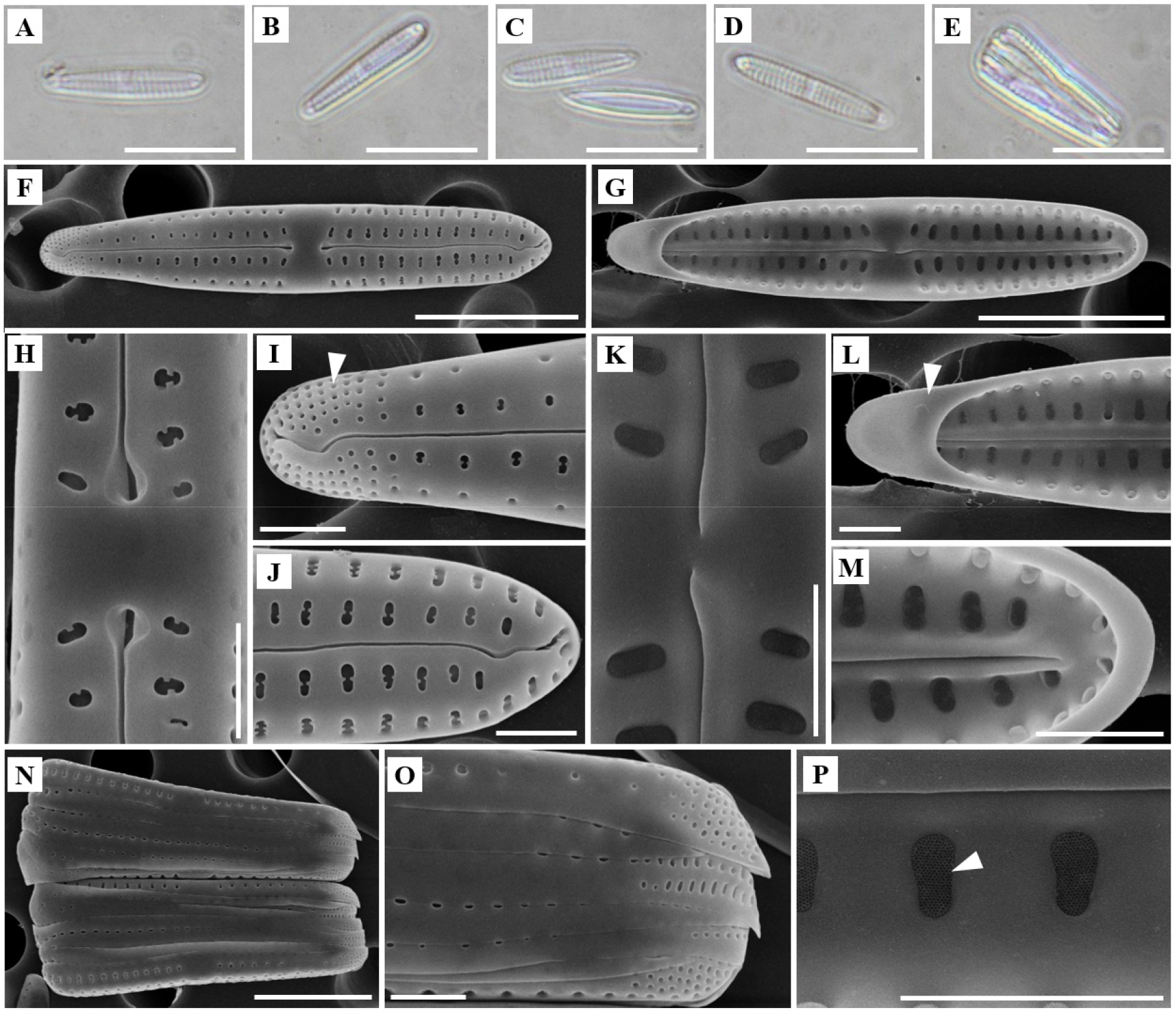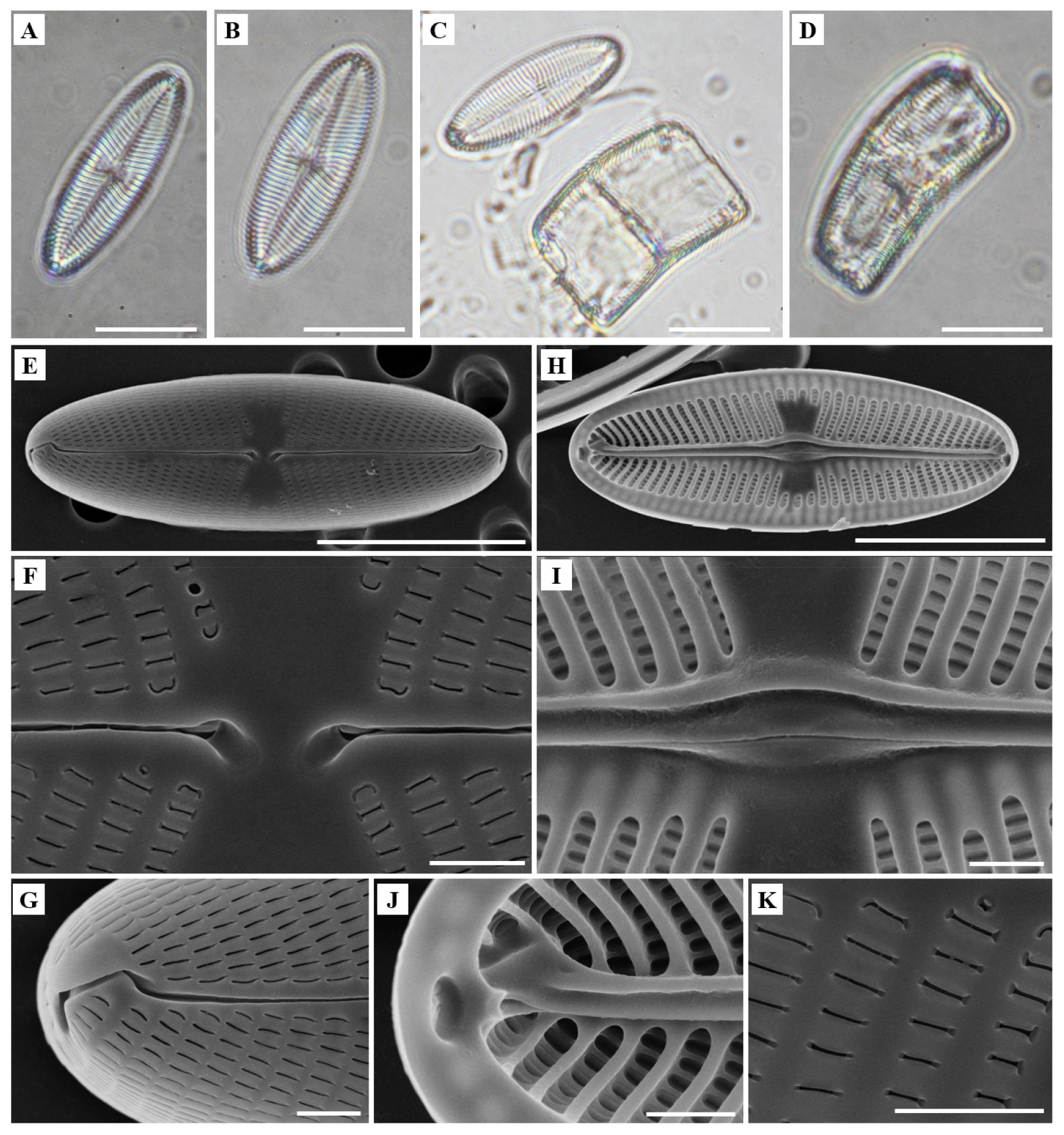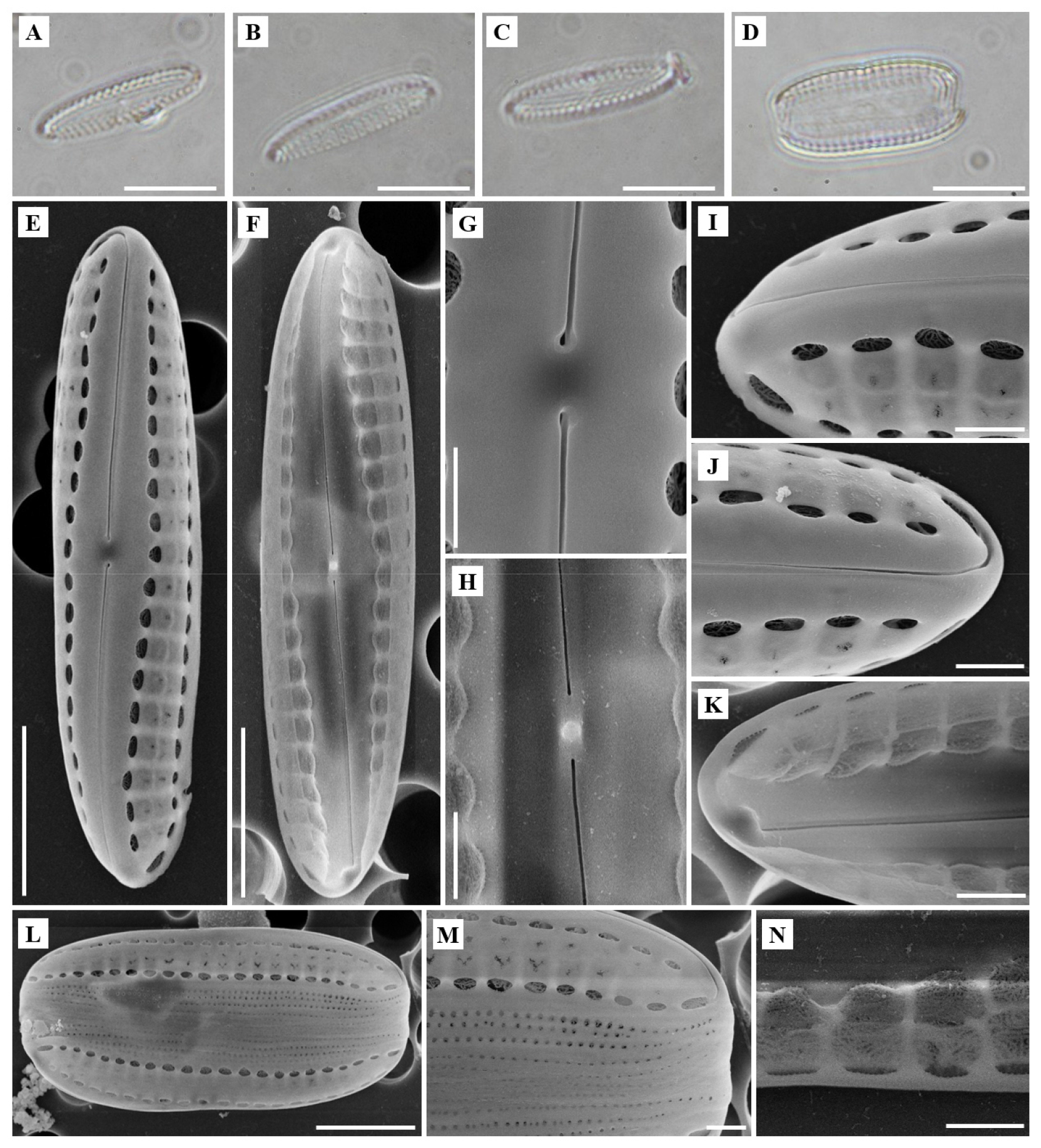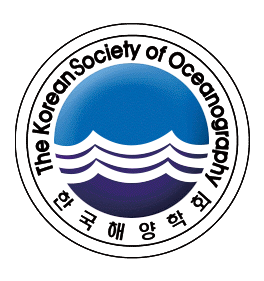1. 서 론
미세조류는 해양 생산량의 40-45%를 차지하여 전 세계 모든 열대우림보다 높은 생산성을 가진 것으로 추정되고 있으며, 탄소와 규소의 생지화학적 순환과 어업 유지에 중요한 역할을 한다(Mann, 1999). 이중 단세포 미세조류인 규조류는 전 세계 탄소 고정의 약 20%를 차지하여 해양 탄소 순환에 중요한 기여를 하고(Field et al., 1998), 수생 식물군의 중요한 요소로서(Allan and Castillo, 2007) 하천, 해양, 퇴적물 등 모든 유형의 수생 환경에 보편적으로 분포한다(Al-Yamani and Saburova, 2011).
저서 규조류는 조간대 갯벌 해역의 바닥 퇴적물에도 많이 분포한다. 조간대는 온도, 빛, 영양염 등 물리 화학적 환경 변화가 크게 일어나고 간조 시에는 탁도가 매우 높아 저서 규조류에게는 매우 가혹한 서식 환경을 제공하는데(Kim et al., 2017), 이곳에 서식하는 저서 규조류는 이런 지역적 특성이 반영된 서식 환경에 모두 적응한 종들로 볼 수 있다(Admiraal, 1984; Underwood and Kromkamp, 1999).
규조류는 분류학적으로는 크게 3개의 강(class)으로 구성된다. Algaebase에는 Bacillariophyceae 14,702종, Coscinodiscophyceae 1,644종, Mediophyceae 1,916종, 분류학적 위치가 불명확한 분류군(Bacillariophyceae incertae sedis) 487종을 포함하여 총 18,749종이 알려져 있다(Guiry and Guiry, 2023).
국내에서는 2015년에 2,015종(NIBR, 2015), 2022년에 2,263종(NIBR, 2022)이 기록종으로 보고되었다. 8년간 248종이 추가되어 규조류 분류 연구가 꾸준히 진행되었음을 알 수 있다. 하지만 대부분 기수역과 담수역을 대상으로 한 연구이고 해양이나 조간대 해역에 대한 연구는 미미하였다. 지역적 특성이 크게 반영되는 조간대 해역의 독특한 서식 환경과 저서 규조류의 수평적인 이동 범위의 제한성을 고려하면 조간대 해역에서는 국내 미기록종과 신종이 출현할 가능성이 높다. 국내 해역의 생물 다양성 측면에서도 더 많은 조간대 해역에 대하여 더 많은 연구가 필요하다.
최근 3년간 Bacillariophyceae에 대한 국내 기수 및 해양 연구를 살펴보면, 2020년에 Kim et al.(2020a)이 황해에 많이 출현하는 Navicula spartinetensis을 미기록종으로 발표하였고, Im et al.(2020)이 인천의 갯벌 해역과 부안의 모래 갯벌에서 2종의 Tryblionella 미기록종을 보고하였다. Kim et al.(2020b)은 태안에서 Proschkinia 5신종을 발표하였다. 2021년에 Joh(2021)는 제주도 서귀포에 분포하는 Cocconeis 25종에 대하여 기술하였고, An et al.(2021)은 함평만의 갯벌에서 국내 미기록종인 Surirella atomus를 발표하였다. 2022년 Kim et al.(2022)은 서해의 갯벌 조간대에서 Fogedia orientalis 신종을 보고하였고 An et al.(2022)은 형태 및 분자생물학적 연구를 통하여 Halamphora minima 신종을 발표하였다. 담수에서는 2020년 Miao et al.(2020)이 한강의 지류로부터 Achnanthidium 신종 2종을 발굴하였고 2021년에 Kwon et al.(2021)이 6개의 석호로부터 Cosmioneis citriformis, Diploneis didyma 등 미기록종 11종을 발표하였으며, 2022년 Hwang et al.(2022)이 Hannaea librata, Gomphonema seminulum, Nitzschia inclinata 3종을 신종으로 발표하였다.
본 논문은 국내 조간대 해역에 출현하는 저서 규조류를 발굴하기 위하여 서해, 남해, 제주의 특정 조간대 해역을 대상으로 연구를 수행한 결과이다. 저서 규조류의 서식 환경은 조간대 해역이 육지 해안선과 연속성 상에 있는지 여부와 외해에 개방된 정도에 따라 다르기 때문에 서해안, 남해안, 제주도의 조간대 해역에는 각자 다른 저서 규조류 분류군이 서식할 가능성이 높다. 여기에서는 세 해역에서 발견한 국내 미기록 규조류 7종, Gomphoseptatum aestuarii, Rhoiconeis pagoensis, Seminavis exigua, Plagiolemma distortum, Staurotropis seychellensis, Biremis sigmoidea, Liriogramma sarcophagus의 주사전자현미경으로 분석한 형태분류학적 특성을 보고한다.
2. 재료 및 방법
시료는 2016년부터 2023년까지 서해와 남해 및 제주의 5개 조간대 해역에서 채집하였다(Table 1). 대상 해역에서 해수, 모래, 작은 자갈을 채집하였고 실험실에서 파스퇴르 피펫(Hilgenberg GmbH, Germany)으로 규조류를 분리하여 24 well (ISO 13485, SPL, Korea)에 1차 배양하였다. 배양액은 멸균 해수에 f/2 배지와 Si를 첨가하여 제조하였다. 배양에 성공한 순수 분리종들은 125 ml PC bottle (20150125, Nalgene, USA)에 넣어 수온 18℃, L:D cycle 16:8, 광량 100 μmol/photons 조건에서 배양하였다. 주사전자현미경(S-4800+EDS, Horiba : EX-250, Hitachi, Japan) 전처리는 Hasle and Fryxell(1970)의 방법을 따랐고, 준비된 시료를 백금으로 40초간 Ion Sputter (E-1045, Hitachi, Japan)로 코팅한 후 가속전압 5kV로 관찰하였다.
Table 1.
Sampling information in Korean tidal flat
3. 결 과
Algaebase(2023) 체계 기준(23년 11월)으로 2강 3목 5과 7속 7종의 국내 미기록종을 조간대 해역에서 발견하였다. 이들의 분류학적 특성, 광학/전자현미경 이미지, 참고문헌, 형태 특징 및 분포를 기재한다.
Phylum Heterokontophyta
Class Bacillariophyceae
Order Cymbellales
Family Rhoicospheniaceae
1. Gomphoseptatum aestuarii (Cleve) Medlin 1986
Order Naviculales
Family Naviculaceae
2. Rhoiconeis pagoensis Lobban 2015
3. Seminavis exigua Changping Chen, Suqing Zhuo & Yahui Gao 2019
Family Plagiotropidaceae
4. Plagiolemma distortum Nézan 2018
5. Staurotropis seychellensis (Giffen) Paddock 1988
Family Scoliotropidaceae
6. Biremis sigmoidea Al-Handal 2019
Class Bacillariophyceae classis incertae sedis
Order Bacillariophyceae ordo incertae sedis
Family Bacillariophyceae familia incertae sedis
7. Liriogramma sarcophagus (Wallich) D.Z.Lan 1995
Gomphoseptatum aestuarii (Cleve) Medlin 1986 (Fig. 1A-P)
Basionym:Gomphonema aestuarii Cleve 1893
Synonym:Gomphonema valentinica Nikolajev 1969; Medlin 1981
참고 문헌:Medlin and Round(1986), p. 212, fig. 16-18, 55-59 Li et al.(2020), p. 277-280, fig. 18-41
기준서식지: 영국, Hastings
표본 번호: MABIK DI00043475
분포: 2023년 2월 남해군 석평리, 점토 patch
형태 특징:G. aestuarii는 위 아래가 비대칭인 heteropolar 타입으로 valve 가운데는 직선형이지만 끝으로 갈수록 둥글다. 길이 14-15.9 μm, 폭 2.4-2.9 μm, 10 μm 이내 transapical striae는 19-22개다.

Fig. 1.
Light (LM) & Scanning electron microscopy (SEM) images. (A-P) Gomphoseptatum aestuarii. (A-E) cleaned specimens in LM. (F) External view of whole valve. (G) Internal view of whole valve. (H) Externally central raphe endings expanded, broad hyaline fascia. (I), (J) Close-up apical raphe ending, strongly hooked in the same directions, foot pole with radiated areolae (white arrow). (K) Externally central raphe endings expanded, broad hyaline fascia. (K) Internal raphe endings slightly hooked. (L), (M) Foot pole with a strongly developed pseudoseptum (white arrow), small helictoglossae. (N), (O) Girdle with several band, composed of single poroid. (P) Reticulated areolae (white arrow). Scale bar (A-G, N) 5 μm, (H-M, O, P) 1 μm.
Rhoiconeis pagoensis Lobban 2015 (Fig. 2A-K)
참고 문헌:Lobban(2015), p. 14, fig. 131-138
기준서식지: 괌, Pago Bay
표본 번호: MABIK DI00043476
분포: 2021년 11월 제주 서귀포시 대정읍 신도리, 해조류(Sargassum)
형태 특징: Valve는 linear-elliptical하며 끝이 둥글다. striae는 valve를 중심으로 방사형이며 areola는 slit-like다. 바깥쪽 valve의 raphe는 central raphe endings이 존재하지만 안쪽은 두껍게 하나의 raphe로 연결된다. 세포의 길이는 23.4-26.0 μm, 폭은 7.7-8.8 μm다. 10 μm 내 striae는 18-20개다.

Fig. 2.
Light (LM) & Scanning electron microscopy (SEM) images. (A-K) Rhoiconeis pagoensis. (A-D) cleaned specimens in LM. (E-K) SEM. (E) External view, linear-elliptical with obtusely rounded apices. (F) External raphe endings expanded, tear-drop shaped. (G) Internal raphe endings strongly curved. (H) Internal view, ‘butterfly’ shaped central area, strongly radiate striae. (I) The siliceous ribs near the raphe. (J) Small hole above helictoglossae. (K) Slit-like areolae at external valve. Scale bar (A-E, F) 10 μm, (F, I-K) 1 μm.
Seminavis exigua Changping Chen, Suqing Zhuo & Yahui Gao 2019 (Fig. 3A-K)
참고 문헌:Chen et al.(2019), p. 87-90, fig. 2-25
기준서식지: 중국, 푸젠성, 후이안현
표본 번호: MABIK DI00043477
분포: 2021년 4월 군산시 비응도, 모래
형태 특징: Valve는 끝 부분이 약간 둥근 semi-lanceolate이다. 바깥쪽 valve의 raphe ending이 강하게 구부러져 있고 길이는 12.9-18.3 μm, 폭은 3-4 μm다. Terminal raphe ending은 강하게 휘어지며 ventral striae는 1개의 areola로 구성되어 있다. 10 μm 내 striae는 등 방향(dorsal)에 18-21, 배 방향(ventral)에는 19-22개다.

Fig. 3.
Light (LM) & Scanning electron microscopy (SEM) images. (A-K) Seminavis exigua. (A-D) cleaned specimens in LM. (E) External view of whole valve with single row in the ventral side. (F) Girdle composed of plain band with wide valvocopula (white arrow). (G) Transapical striae elongate, parallel, central raphe slightly hooked. (H) External raphe endings strongly hooked in the dorsal view, single row of pores around raphe endings. (I) Internal view of whole valve. (J) Central raphe endings positioned within a rib, small central nodule (white arrow). (K) Apical raphe ending with distinct helictoglossae. Scale bar (A-F, I) 5 μm, (G, H, J, K) 1 μm.
Plagiolemma distortum Nézan 2018 (Fig. 4A-J)
참고 문헌:Nézan et al.(2018), p. 3-10, fig. 2-32
기준서식지: 프랑스, Ouessant 섬, Bay of Lampaul
표본 번호: MABIK DI00043478
분포: 2022년 12월 군산 비응도와 부안 진서면, 모래, 점토
형태 특징: Valve는 가장자리가 기복이 심한 강한 아치형을 보이고 있다. 안쪽을 살펴보면 central raphe 위쪽에 1개의 pseudostauros가 존재한다. Raphe는 강한 S자 형태이며 central raphe가 끊어지지 않고 하나로 연결된다. areolae는 Navicula에서 볼 수 있는 slit 구조이다. 세포의 길이는 31.1-39.5 μm, 폭 11-12 μm이며 10 μm 내 striae의 수는 22-27개다.

Fig. 4.
Light (LM) & Scanning electron microscopy (SEM) images. (A-J) Plagiolemma distortum. (A-C) cleaned specimens in LM. (D) External valve view with strongly sigmoid raphe. (E), (G) Central raphe endings undulated, slit-like areolae. (F) External raphe endings with rounded pore (white arrow), beyond single row of elongated areolae (black arrow). (H) Internal valve view with short pseudostauros (white arrow). (I), (J) Apical raphe endings distinct helictoglossae in the internal view. Scale bar (A-D, H) 10 μm, (E-G, I, J) 1 μm.
Staurotropis seychellensis (Giffen) Paddock 1988 (Fig. 5A-J)
Basionym:Tropidoneis seychellensis Giffen 1980
Synonym:Tropidoneis seychellensis Giffen 1980, Plagiotropis seychellensis (Giffen) Kennett 1984
참고 문헌:Ashworth et al.(2016), p. 59-62, fig. 9, 10
기준서식지: 쿠바, 카리브해 도서
표본 번호: MABIK DI00043479
분포: 2017년 8월 군산 비응도, 모래
형태 특징: Valve 끝부분에서 keel-like raphe ridge를 형성하며 valve outline은 가운데 부분이 움푹 들어가는 강한 waisted 형태다. 안쪽 valve에는 두꺼운 stauros가 존재하며 areola는 사각형에 4-7개의 velum를 가지고 있다. 세포의 길이 68-72 μm, 폭 10-13 μm이며 10 μm 내의 striae는 27-29개다.

Fig. 5.
Light (LM) & Scanning electron microscopy (SEM) images. (A-J) Staurotropis seychellensis. (A-D) cleaned specimens in LM. (E) Exterior valve in valve view. (F) Central raphe elevated raphe keel. (G), (H) Interior valve of central valve showing distinct stauros with rounded pore. (I), (J) Slightly quadrate cribra on valve face, 4-7 areolae pore. Scale bar (A-E) 30 μm, (F-J) 1 μm.
Biremis sigmoidea Al-Handal 2019 (Fig. 6A-N)
참고 문헌:Al-Handal and Al-Shaheen(2019), p. 1-252, incl. 62 pls (652 figs).
기준서식지: 이라크, Shatt Al-Arab estuary
표본 번호: MABIK DI00043480
분포: 2022년 12월 부안군 진서면, 신안군 압해도, 점토
형태 특징: Valve는 linear-elliptical하며 직선적이고 끝이 둥근 형태를 하고 있다. Raphe는 완만하게 S자 형태를 하고 있으며 valve 바깥쪽 raphe ending이 강한 갈고리 모양으로 휘어져 있다. 세포의 길이는 19.5-20 μm, 폭은 5 μm이며 10 μm 내에 striae 개수는 11-13개이다.

Fig. 6.
Light (LM) & Scanning electron microscopy (SEM) images. (A-N) Biremis sigmoidea. (A-D) cleaned specimens in LM. (E) External valve view. (F) Internal valve view with sigmoid raphe. (G) Central raphe endings slightly expanded (external). (H) Central raphe endings straight with distinct central nodule (internal). (I), (J) Foramina on the valve face, apical raphe endings strongly hooked. (K) Internal raphe endings with small helictoglossae. (L), (M) Frustules slightly rectangular in girdle view, valvocopula composed of single row. (N) The chambers porous in the interior wall. Scale bar (A-F, L) 5 μm, (G-K, M, N) 1 μm.
Liriogramma sarcophagus (Wallich) D.Z.Lan 1995 (Fig. 7A-L)
Basionym: Asteromphalus sarcophagus Wallich 1860
Synonym: Asteromphalus sarcophagus Wallich 1860
참고 문헌:Rivera and Barrales(1990), p. 38-44, fig. 1-30
기준서식지: 인도양, Salpae
표본 번호: MABIK DI00043481
분포: 2023년 2월 남해군 송정리, 작은 자갈.
종 특성: Valve는 elongate이며 원형에서 타원형까지 다양하다. 세포의 길이는 33-35 μm, 폭 11-12 μm이다. 10 μm내에 9-11개의 striae를 가지고 있다. 6개의 좁은 hyaline rays는 valve 가장자리까지 확장된다.

Fig. 7.
Light (LM) & Scanning electron microscopy (SEM) images. (A-L) Asteromphalus sarcophagus. (A-D) cleaned specimens in LM. (E) External valve view. (F), (G) All hyaline rays extend near to edge of the valve, rounded ends. (H) Close-up external cribra, slightly rounded. (I) Largely labiate process expanded in the external raphe ending. (J) Internal valve view. (K), (L) Rounded pores within internal foramen, each rays distinct labiate processes. Scale bar (A-E, J) 10 μm, (F-I, K, L) 1 μm.
4. 토 론
이번 연구를 통해 우리나라에 기록되지 않은 7종을 군산시 비응도, 부안군 진서면, 신안군 압해도, 남해군 석평리, 서귀포시 신도리 조간대 해역의 모래, 자갈, 해조류에서 발견하였다. 이 중 Rhoiconeis, Plagiolemma, Staurotropis, Liriogramma 4개 속은 국내에서 처음으로 보고한다.
Rhoiconeis pagoensis는 2021년 11월 제주 서귀포에 위치한 신도포구의 Sargassum으로부터 발견된 종이다. Rhoiconeis는 Grunow(1863)가 R. bolleana를 발표하면서 최초로 보고한 속으로 현재 R. pagoensis, R.sponsalia, R. trigonocephala를 포함한 단 4종만 보고되어 있다. Rhoiconeis는 형태적으로 Achnanthes 속과 유사하지만 Achnanthes는 raphe가 하나인 반면, Rhoiconeis는 raphe가 두 개 이다(Lobban, 2015). 이번 연구에서 발견한 종은 R. bolleana보다 길이와 폭이 작은 반면 10 μm 내 striae 수는 약 2배 가량 많았다. R. sponsalia와는 길이와 폭이 비슷하지만 10 μm 내 striae 수는 약 1.4배 많았다(Table 2). Lobban(2015)이 발표한 R. pagoensis는 안쪽 valve 사진이 없어서 본 시료와 직접 비교하기 어렵지만 길이와 폭, 10 μm 내 striae 수에서 모두 동일한 범위를 보였다.
Table 2.
Comparison of Rhoiconeis species
Plagiolemma distortum은 2022년 12월 군산 비응도의 모래사장에서 발견하였다. Plagiolemma는 전 세계적으로 P. confusum, P. distortum 단 2종만 기록된 속이다. P. distortum은 Nézan et al.(2018)이 신종으로 발표한 이후 국내에서 발견하기 전까지는 프랑스령의 영국해협에서만 관찰되었다. 국내에서 발견한 P. distortum은 형태 및 미세구조, 미약하게 보이는 pseudostauros 등 많은 형태 특성이 Nézan et al.(2018)이 발표한 종과 동일하였다. 본 시료는 2022년 12월 군산과 부안에서 분리 배양한 시료이지만, 이미 2016년 12월에도 본 연구진이 학암포 해수욕장의 해조류에서 발견하여 배양했던 종이다. 이로 미루어 볼 때 본 종은 겨울철 국내 서해안에 폭넓게 분포하는 것으로 판단된다.
Staurotropis seychellensis는 대서양과 영국해협, 태평양 괌 해역, 프랑스와 쿠웨이트 등에서 보고된 종으로(Ashworth et al., 2016), 국내에서는 2017년 9월 군산 비응도의 모래사장에서만 한차례 발견되었다.
Liriogramma는 1954년 Kolbe가 처음으로 보고된 속으로 현재 L. petterssonii와 L. sarcophagus 2종만 기록되어 있다(Guiry and Guiry, 2023). L. sarcophagus는 Wallich(1860)가 Asteromphalus sarcophagus로 발표하였지만 Lan et al.(1995)에 의해 Liriogramma 속으로 이전되었다. 하지만 아직 그 계통학적 위치는 명확하게 확립되지 않았다. L. sarcophagus는 대서양, 중동, 호주, 태평양 등 전세계적으로 흔하게 분포하는 종이지만 국내에서는 이번에 처음으로 보고한다. Liriogramma속 또한 국내에서 처음으로 보고하는 속이다.
Gomphoseptatum aestuarii는 남해 석평리에서 2월에 점토에서 분리하였다. Gomphoseptatum은 현재 전세계적으로 G. aestuarii와 G. pseudoseptatum 단 2종만이 기록되어 있다. G. aestuarii는 Cleve(1893)에 의해 Gomphonema 속으로 최초 분류되었지만 Medlin and Round(1986)이 다른 Gomphonemoid 속들과 달리 foot pole의 pseudoseptum이 두드러지고 head pole에 있는 valvocopula의 septum이 있는 점을 들어 Gomphoseptatum속으로 옮겼다. 비응도에 출현한 G. aestuarii는 Medlin and Round(1986)의 형태와 미세구조가 일치하였다. 지역적으로 주로 온대 해역에서 한랭 해역까지 분포하며 미국, 캐나다, 멕시코, 독일, 아이슬란드, 한국, 일본 및 남아프리카 연안 해역에서 보고되었다(Li et al., 2020).
Seminavis exigua는 군산시 비응도에서 4월에 모래 시료에서 발견하였다. S. exigua는 Chen et al.(2019)이 2018년 4월 중국 푸젠성 Chongwu 반도의 모래에서 발견한 종이다. Seminavis는 22종이 기록되어 있으며 그중 ventral stria가 1줄로 존재하는 종은 S. exigua와 S. macilenta 2종뿐이다. 군산에서 출현한 Seminavis는 S. exigua와 형태 및 미세구조가 일치하였다.
Biremis sigmoidea는 Al-Handal and Al-Shaheen(2019)이 Shatt Al-Arab 하구에서 발견하여 보고한 종이다. Biremis는 현재까지 19종이 보고되었는데, 이 종은 raphe가 직선이 아닌 S자 형태를 하고 있어 다른 종과 쉽게 구분이 된다. 국내에서는 12월에 부안군 진서면과 신안군 압해도 갯벌 조간대에서 발견하였고, S자 모양의 raphe는 완만하게 휘어져 있다.
이번에 발굴한 7종 중 L. sarcophagus를 제외한 6종은 국내 갯벌 해역에서 분리한 pennate 규조류이다. 그 중 3종의 미기록종(Seminavis exigua, Plagiolemma distortum, Staurotropis seychellensis)은 군산시 비응도 한 지역에서만 발굴되었다. 공간 범위를 다른 해역으로 더 넓히면 더 많은 미기록종과 신종을 발굴할 수 있을 것으로 판단된다.
우리나라 서해안은 세계 5대 갯벌로 불릴 만큼 광활한 갯벌이 형성되어 있다. 그 갯벌 속에서 매우 다양한 저서 규조류들이 분포하고 있지만 분류학적 연구가 미진하여 아직 신뢰할 만한 출현종 현황은 파악하지 못한 상태이다. 저서 규조류는, 해류를 통해 자유롭게 이동할 수 있는 플랑크톤과 달리, 규각이 두껍고 무거워 쉽게 가라앉는다. 이러한 특성 때문에 저서 규조류는 수심이 깊은 먼 바다를 가로질러 이동하기 어렵고 해안선이 복잡한 곳에서는 지역적으로 격리되기 쉽다. 특히 서해처럼 커다란 만의 형태를 하고 외양과 해수 교환이 제한적으로 일어나는 곳에서는 지질학적으로 오랜 기간에 걸쳐 갯벌 환경의 고유 특성에 적응한 종들이 서식할 가능성이 높다. 따라서 차후에는 저서 규조류의 형태 특성 외에 유전학적 특성 연구를 병행하여 서해안 갯벌 해역에 분포할 가능성이 높은 우리나라 고유종이나 신종을 발굴할 필요가 있다.
이번 연구에서 Rhoiconeis pagoensis(괌, 태평양)와 Seminavis exigua(중국, 황해)를 제외한 5종은 기준서식지가 북유럽 대서양 연안(Gomphoseptatum aestuarii, 영국; Plagiolemma distortum, 프랑스), 카리브해(Staurotropis seychellensis, 쿠바)와 인도양(Biremis sigmoidea, 이라크; Liriogramma sarcophagus, Salpae)인 종으로 지리적으로 멀리 떨어져 있음에도 형태적으로 거의 일치하였다. 하지만 형태가 유사하더라도 지리적으로 멀리 떨어져 있는 경우에 서로 다른 종으로 밝혀진 경우가 많다. 국내 출현이 보고된 종에 대해서도 유전자 분석을 병행하여 다른 해역의 종들과 동일한 종인지 확인할 필요가 있다.




